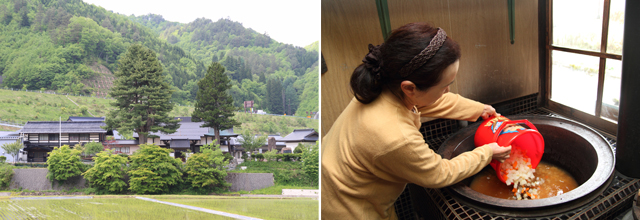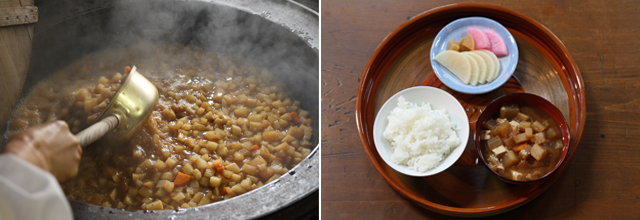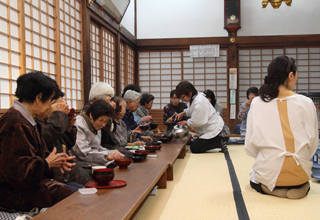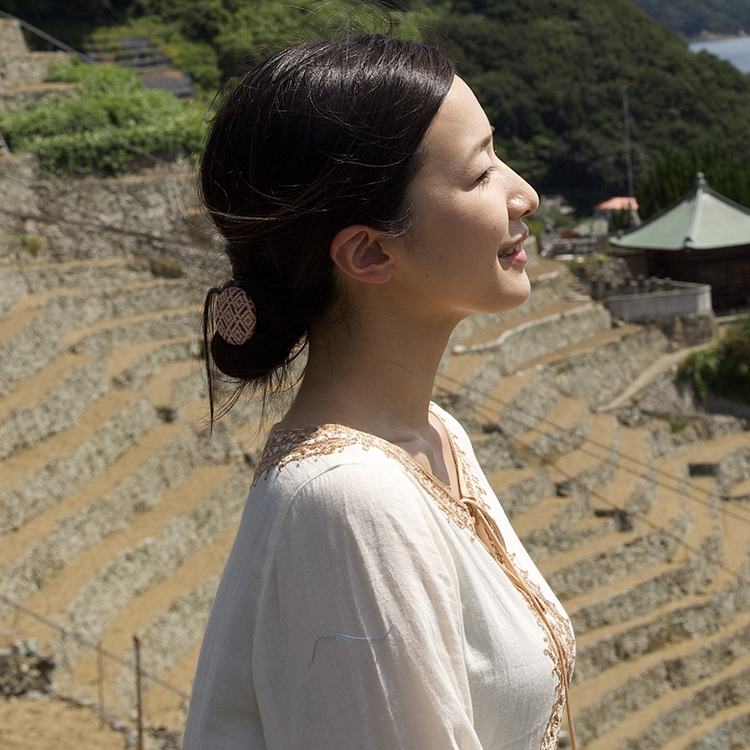Ritual Cuisine: Japanese Food Culture in Festive Dishes
Nov 07,2013
Ritual Cuisine: Japanese Food Culture in Festive Dishes
Nov 07,2013
In this series, our editors Nobue and Miyoko speak with experts on such topics as food, customs, Japan, and traditional lifestyles.

Miyoko:What foods do you think of when you hear the term “local cuisine”?
Nobue:Hmmm. Maybe Utsunomiya gyoza dumplings from Tochigi or oden simmered hot-pot in broth from Shizuoka.
Miyoko:Those are good examples. We are familiar with hearing about certain foods, like local specialties or affordable gourmet dishes, when talking about a certain region. Today, however, we are going to talk with Kiyoshi Aya, a researcher who looks at local cuisine from a slightly different angle than these categories.
Nobue:Sounds excellent. I wonder what stories we will hear.
Miyoko / Nobue: To get started, could you tell us a bit about your research activities?
Kiyoshi:I study and research local cuisine and, in particular, dishes and meals prepared for special events. This means dishes and meals eaten whenever people gather, whether for annual events or for weddings, funerals, or other ceremonies. Recently, I’ve been focusing my research on dishes made for special occasions served at temples in the mountainous areas of the Chubu region, which includes the prefectures of Toyama, Ishikawa, Fukui, and Gifu.
Nobue:At temples?
Kiyoshi:Yes. Local cuisine certainly includes a region’s renowned dishes that are often used for tourism. But I’m interested in more than the dishes themselves; I want to learn about their background, their history, and their connections to how people live in the local area. Rather than in the meals and dishes served in restaurants, I think the “essence” of food is found in meals people prepare for themselves and meals prepared for communal eating, when people come together to eat.
Aside from temples, there are, of course, local cuisine and special-occasion meals passed down within families. The issue with family meals is that at any point, the family may decide to give up the tradition. They may get tired of it, and with that, the tradition disappears. In the case of temples, there are many examples of foods and dishes prepared for special occasions that are preserved by the local community. In each community, roles are assigned to different people who take responsibility for passing on the traditional methods. As a result, relatively antiquated practices are still carried on.
Nobue:How do you specifically go about your research?
Kiyoshi:Because I studied history in university, I sometimes read and look things up in old documents. But the main part of my research is field work, where I go out and interview people in their local communities. When possible, I try to stay at a temple for around two weeks. There, I help with chores like cleaning and ringing bells and fit into the daily routines. Then, I participate in an event and observe how the locals make their event meals and dishes.
Miyoko:Why did you decide to research local cuisines and dishes made for special occasions?
Kiyoshi:I’ve always been interested in food, maybe because both my mother and grandmother were home economics teachers. I also love traveling. When I was a student, I traveled abroad a lot. Eventually, I realized that I knew next to nothing about my own country. During a stay in Kochi, an older man in the house next door shared some meat from a deer he had just shot. He seared the meat lightly over an open fire in a tataki method, and I was struck by just how delicious it was. Having grown up in Osaka, the experience of eating freshly killed deer itself was astonishing to me. But more than anything, my curiosity was piqued by this Japan right before my eyes that I knew nothing about. Another part of it was my family ran a temple, so people in the community would often bring us meals that they had cooked at home. When I think about it now, I realize I was brought up surrounded by local cuisine and dishes made for special occasions.

Miyoko:What’s one particular dish you can tell us about from the many local and special-occasion dishes that you’ve studied?
Kiyoshi:One would be okojiru, a tradition in Takayama, Gifu. Okojiru is eaten by the local community at a Jodo Shinshu Buddhist event known as Hoonko [a memorial service for the founder of the sect, Shinran Shonin] at a local temple. The way the okojiru is prepared is truly unique. When the annual day of the event comes around, people from some 20 households in the community gather at the temple carrying by hand lidded buckets and bundles wrapped in furoshiki cloth wrappers. A large pot is placed in the temple’s hearth, and the people, one after another, pour daikon radishes and miso from their buckets into the pot. Most of the miso is homemade. Each home brings its signature temae miso with its own characteristic flavor. All these ingredients are combined to make one large daikon-flavored miso soup.

Nobue:That’s so interesting.
Kiyoshi:When it’s time to eat, the meal, which is called otoki, is shared among everyone. Rice and pickles brought by the attendees are also spread out and everyone eats together.
Nobue:Does the okojiru taste good?
Kiyoshi:It tastes amazingly good. It’s the ultimate miso soup blend, consisting as it does of 20 different types of miso. It has a very rich flavor.
Otoki is not only a delicious meal but also a deeply rooted event for the people in the community that has been passed down for generations. It serves as a venue for communication among neighbors. And since it takes place right after the autumn rice harvest, it is also a celebration in a sense.

Kiyoshi:Someone told me a story about okojiru. In the area lives a healthy 103-year-old woman who never misses her morning routine of following a radio exercise program. Apparently, this woman had a serious health crisis when she was around 80. Her appetite dwindled, and she couldn’t eat anything. Her daughter-in-law was very concerned and asked, “Is there anything you can eat?” The woman replied, “I want to eat okojiru.” So the daughter-in-law asked her neighbors for help, gathered their miso, and made okojiru. Delighted, the woman ate it and fully recovered. She’s now a vibrant 103-year-old.
Miyoko:That’s wonderful!
Kiyoshi:In one sense, okojiru is just regular miso soup. But the taste of that soup touched and revived something deep within that woman. I think it’s truly remarkable that her body remembered the taste of okojiru.
Miyoko:The fact that the taste of okojiru can’t be replicated by just one family makes it that much more interesting and profound.
Kiyoshi:That’s right. This is a place where people help each other by shoveling snow in winter and supporting each other’s daily life. So the time spent bringing ingredients, cooking together, and sharing meals is invaluable for maintaining community bonds.

Nobue:On the other hand, isn’t the population of this community aging?
Kiyoshi:Yes, it is. What I have long sensed in my work is that the end of a food culture is equivalent to the collapse of a community. The reverse is also true. However, I can understand — because I, too, live in a city — that in an era where individuals are prioritized, it’s inevitable, in a way, that people avoid close ties and move toward nuclear families. We want to preserve these food cultures, but it involves complex challenges.
Kiyoshi:I really want young people to take an interest in local cuisines and dishes prepared for special occasions. I hope they have as many opportunities as possible to experience the flavors of their region at a young age. I want them to experience the joy of cooking together and eating together, and to remember the flavors of their region from their childhood.
Miyoko:Experiences like those from childhood will remain with you as an adult.
Kiyoshi:Another question I’d like to raise is whether we have become too accustomed to food that provides instant gratification. We are surrounded nowadays by so many stimulating flavors. Compared to these flavors, the flavors of local delicacies and dishes prepared for special occasions may seem bland to people today. But I wonder if it’s fair to judge food solely on whether or not it tastes good. Think, for example, of nare-zushi, which is found in various parts of the country. Nare-zushi is made through lactic-acid fermentation of fish in brine and rice: funa-zushi [fermented crucian carp sushi] in Shiga is a well-known example. It’s unlikely that the uninitiated will think that nare-zushi tastes good. But since this preparation method exists nationwide, it implies there is some reason for its longevity. It turns out that it was an important preserve in the past when fresh fish wasn’t readily available. Understanding this kind of historical context is important, not only for learning about culture but also for reflecting on our modern lifestyles. I especially want to convey this message to children.

Miyoko:The local cuisines and dishes prepared for special occasions that exist across the country, but are also slowly disappearing, contain many messages worth passing on to today’s Japan.
Miyoko / Nobue:Thank you very much for joining us today.

food culture researcher
food culture researcher
food culture researcher and Secretary of the Research Division at the National Council for Washoku Culture
Born in Osaka prefecture, Kiyoshi is involved in researching traditional regional Japanese cuisine and the dietary habits in fishing and farming communities as well as writing and giving lectures about local foods.
Recent publications include Washoku Techo [Washoku Handbook] (co-author, published by Shibunkaku), Furusato no Tabemono [Hometown Food] (Washoku Culture Booklet No. 8) (co-author, published by Shibunkaku), and Shoku no Chizu [Maps of Food], Third Edition (published by Teikoku-Shoin).